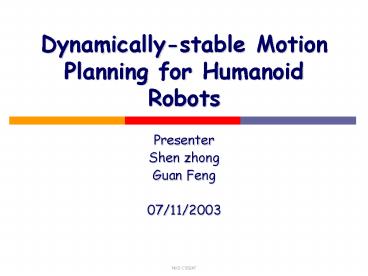Dynamically-stable Motion Planning for Humanoid Robots - PowerPoint PPT Presentation
1 / 21
Title: Dynamically-stable Motion Planning for Humanoid Robots
1
Dynamically-stable Motion Planning for Humanoid
Robots
- Presenter
- Shen zhong
- Guan Feng
- 07/11/2003
2
Paper information
- Authors
- James Kuffner, Jr., Satoshi Kagami, Masayuki
Inaba and Hirochika Inoue - Address
- Dept. of Mechano-Informatics, The university of
Tokyo - http//www.jsk.t.u-tokyo.ac.jp/kuffner/humanoid
3
Outline
- Introduction of motion planning
- Motivation
- Robot model and problem
- Path search
- Statically-stable postures generation
- Experiments
- Discussions
4
Introduction
- Complete algorithms exist for general class of
problem, but their computational complexity
limits their use to low-dimensional configuration
spaces - Path planning methods using randomization are
incomplete - The goal is to develop randomized methods
- Converge quickly
- Simple enough to yield constant behavior
- Maintain robot static and dynamic stability
5
Motivation
- Develop a simulation environment to provide
high-level software control for humanoid robot - The software automatically computes object
grasping and manipulation trajectories through a
combination of inverse kinematics and randomized
holonomic path planning
6
Motivation
- One part of the software is to design an
algorithm for computing stable collision-free
motions for humanoid robots given full-body
posture goals
7
Difficulties
- High dimensions 30 or more
- Maintain overall static and dynamic stability
8
Solutions proposed
- Randomized planner
- RRT-Connect An efficient approach to
single-query path planning. In proc.IEEE Intl
Conf. on Robotics and Automation (ICRA2000), San
Francisco - Utilize Rapidly-exploring Random Trees (RRTs) and
try to connect two search trees aggressively - Filter the returned path to maintains dynamic
balance constraints
9
Robot Model and Assumptions
- An approximate model of surrounding environment
can be acquired using stereo vision or other
means - The robot is currently balanced on either one or
both feet - Supporting feet does not move during the planned
motion - A statically-stable full-body goal posture is
given
10
Some notations
- Robot (A) with p links Li (i1,,p) is in
workspace W. The ith link has mass ci relative to
Cartesian frame Fi. - A configuration of the robot is denoted by the
set PT1,T2,,Tp - n denotes the number of DOFs
- A configuration q is defined in C- configuration
space - The set of obstacles are labeled by B
- Cfree denotes the space of collision-free
configurations - X(q) denotes the vector representing the global
position of the center of mass of A - A configuration is statistically-stable if the
projection of X(q) along the gravity vector lies
within the area of support SP - Cvalid denotes the subset of configurations that
are both collision-free and statically-stable - t I ? C denotes a motion trajectory,
t(t0)qinitial, t(t1)qgoal
11
Path Search
- Path planner
- S.Kagami, F.Kanehiro, Y.Tamiya, M.Inaba and
H.Inoue, Autobalancer an online dynamic balance
compensation scheme for humanoid robots, March
2000 - Planner(A,B,qinit,qgoal)? t
- Modified RRT-Connect try to connect two search
trees aggressively
12
Path Search
e
qtarget
q
qnew
qnear
qinit
13
Path Search
14
Path Search
15
Statically-stable postures generation
- Many configurations are collision free but
unstable. - Many configurations q can be generated and stored
in advance. - Using collision detection algorithm.
- computing X(q) and verify that its projection
along g is contained within the boundary of SP.
16
Statically-stable postures generation
17
Statically-stable postures generation
18
Statically-stable postures generation
19
Experiments
270 MHz SGI O2 (R12000) workstation DOF 30 or
more
20
Discussion and limitations
- The planner, having task-level planning
algorithm, is limited to body posture goals and
fixed position for either one or both feet. - Reduction of computation time
- Efficient collision-detection software
- More stable samples
- Analysis of coverage of Cvalid and the
convergence.
21
- Thank you !































